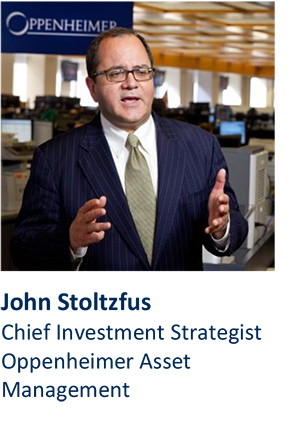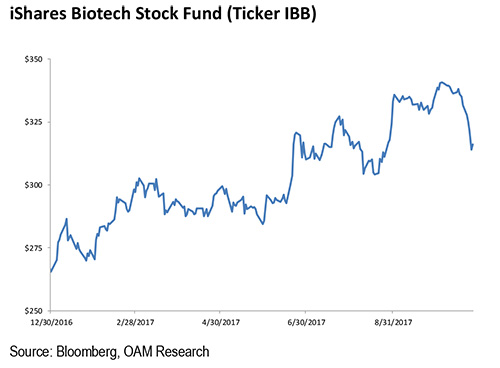Everyday, Everyday I Have the Blues
By John Stoltzfus,
Chief Investment Strategist
Trick or Treat?
A data and decision jammed week presents a degree of uncertainty for investors

This week’s looking like a trick or treat week for investors as a veritable traffic jam of economic data, earnings, and big decision making in Washington lie ahead, each with the potential to worry markets. Whether these will move the markets up or down or by how much and even how soon is yet to seen.
Consider the short list of what lies ahead—along with ongoing Q3 earnings season this week—and a smattering of housing and manufacturing data:
All in all there will be plenty of opportunity over the course of the next few days for investors and the market to consider which direction to take next.
“We continue to expect stocks to rise through the end of the year on expectations for further improvements at the economic and corporate levels”
Last week saw the three major equity indexes in the US post new highs on the back of positive earnings results even as some stocks took nose dives on disappointing results, company transitional concerns, as well as some negative projections of what might lie ahead for others (tied to competitive and other issues) along with some likely normal, healthy profit-taking in other names that surprised positively but drifted lower in price after reporting.
With the Dow, the S&P 500 and the NASDAQ closing last Friday on a year-to-date basis up 18.6%, 15.3% and 24.5% respectively, their gains for the week through last Friday of 0.45%, 0.23% and 1.09% pale somewhat in comparison.
Consider that those same three indices have respectively moved up 29.03%, 21.4% and 29.12% in the latest 12-month period ending last Friday. It’s no wonder that some folks are asking “How long can this keep going on?”
If it weren’t for what we see as decidedly improved fundamentals (economic and corporate, both stateside and in the international realm) we’d think that investors might have good reason to be concerned.
Stocks after all have beaten the expectations of most investors—and even the expectations of many bullish investors.
We find it interesting (and healthy) that even as long-term skeptics and at least some bears now appear to be capitulating of late as stocks moved higher, that investors who “got the upward drift of the stock market” much earlier tend to be concerned rather than ebullient or exuberant about the recent price performance of stocks stateside and abroad.
It’s only when investors consider the improved fundamentals (both economic and corporate) that we believe are underpinning the markets’ moves that their worry dissipates.
Ironic as it may seem to some, the concern and worry investors have shown about the markets’ recent gains as well as over most of the past eight and a half years since the market hit a crisis low on March 9, 2009, gives us reason to believe that “what’s going on” may have a good chance to “go on” for some time into the visible future.
Last week’s earnings from a number of both “old economy” and “new economy” stocks surprised to the upside. Curiously, several technology names whose detractors had questioned their (and their sector’s) ability to deliver the goods in Q3 earnings season surprised in outsized fashion causing the sector to move sharply higher (up 2.9%) on the week.
While technology soared a few biotechnology names gave back some of their recent gains as several widely followed stocks in the sector delivered disappointing news, results, or guidance. The ETFs (exchange traded funds) that track the performance of the NASDAQ Biotech (ticker IBB) and SPDRs S&P Biotech (ticker XBI) indices were respectively off on the week 4.7% and 2.1%.
The declines in those ETFs taken in context of their substantial respective year to date performances of 19.12% and 41.6% appeared in our opinion to acknowledge nearterm disappointment rather than reflect great concern or a change in conviction about the space by investors (see figure below).

Notwithstanding the potential speed bumps or supports the market might get in the week ahead of us, we continue to expect stocks to rise through the end of the year on expectations for further improvements at the economic and corporate levels.
For the complete report, please contact your Oppenheimer Financial Advisor.
Other Disclosures
This report is issued and approved by Oppenheimer & Co. Inc., a member of all Principal Exchanges, and SIPC. This report is distributed by Oppenheimer & Co. Inc., for informational purposes only, to its institutional and retail investor clients. This report does not constitute an offer or solicitation to buy or sell any securities discussed herein in any jurisdiction where such offer or solicitation would be prohibited. The securities mentioned in this report may not be suitable for all types of investors. This report does not take into account the investment objectives, financial situation or specific needs of any particular client of Oppenheimer & Co. Inc. Recipients should consider this report as only a single factor in making an investment decision and should not rely solely on investment recommendations contained herein, if any, as a substitution for the exercise of independent judgment of the merits and risks of investments. The strategist writing this report is not a person or company with actual, implied or apparent authority to act on behalf of any issuer mentioned in the report. Before making an investment decision with respect to any security discussed in this report, the recipient should consider whether such investment is appropriate given the recipient's particular investment needs, objectives and financial circumstances. We recommend that investors independently evaluate particular investments and strategies, and encourage investors to seek the advice of a financial advisor. Oppenheimer & Co. Inc. will not treat non-client recipients as its clients solely by virtue of their receiving this report. Past performance is not a guarantee of future results, and no representation or warranty, express or implied, is made regarding future performance of any security mentioned in this report. The price of the securities mentioned in this report and the income they produce may fluctuate and/or be adversely affected by exchange rates, and investors may realize losses on investments in such securities, including the loss of investment principal.
Oppenheimer & Co. Inc. accepts no liability for any loss arising from the use of information contained in this report. All information, opinions and statistical data contained in this report were obtained or derived from public sources believed to be reliable, but Oppenheimer & Co. Inc. does not represent that any such information, opinion or statistical data is accurate or complete and they should not be relied upon as such. All estimates and opinions expressed herein constitute judgments as of the date of this report and are subject to change without notice. Nothing in this report constitutes legal, accounting or tax advice. Since the levels and bases of taxation can change, any reference in this report to the impact of taxation
INVESTMENT STRATEGY
should not be construed as offering tax advice on the tax consequences of investments. As with any investment having potential tax implications, clients should consult with their own independent tax adviser.
This report may provide addresses of, or contain hyperlinks to, Internet web sites. Oppenheimer & Co. Inc. has not reviewed the linked Internet web site of any third party and takes no responsibility for the contents thereof. Each such address or hyperlink is provided solely for the recipient's convenience and information, and the content of linked third party web sites is not in any way incorporated into this document. Recipients who choose to access such third-party web sites or follow such hyperlinks do so at their own risk. The S&P 500 Index is an unmanaged value-weighted index of 500 common stocks that is generally considered representative of the U.S. stock market. The S&P 500 index figures do not reflect any fees, expenses or taxes. This research is distributed in the UK and elsewhere throughout Europe, as third party research by Oppenheimer Europe Ltd, which is authorized and regulated by the Financial Conduct Authority (FCA). This research is for information purposes only and is not to be construed as a solicitation or an offer to purchase or sell investments or related financial instruments. This report is for distribution only to persons who are eligible counterparties or professional clients and is exempt from the general restrictions in section 21 of the Financial Services and Markets Act 2000 on the communication of invitations or inducements to engage in investment activity on the grounds that it is being distributed in the UK only to persons of a kind described in Article 19(5) (Investment Professionals) and 49(2) High Net Worth companies, unincorporated associations etc.) of the Financial Services and Markets Act 2000 (Financial Promotion) Order 2005 (as amended). It is not intended to be distributed or passed on, directly or indirectly, to any other class of persons. In particular, this material is not for distribution to, and should not be relied upon by, retail clients, as defined under the rules of the FCA. Neither the FCA’s protection rules nor compensation scheme may be applied. This report or any portion hereof may not be reprinted, sold, or redistributed without the written consent of Oppenheimer & Co. Inc. Copyright © Oppenheimer & Co. Inc. 2015.